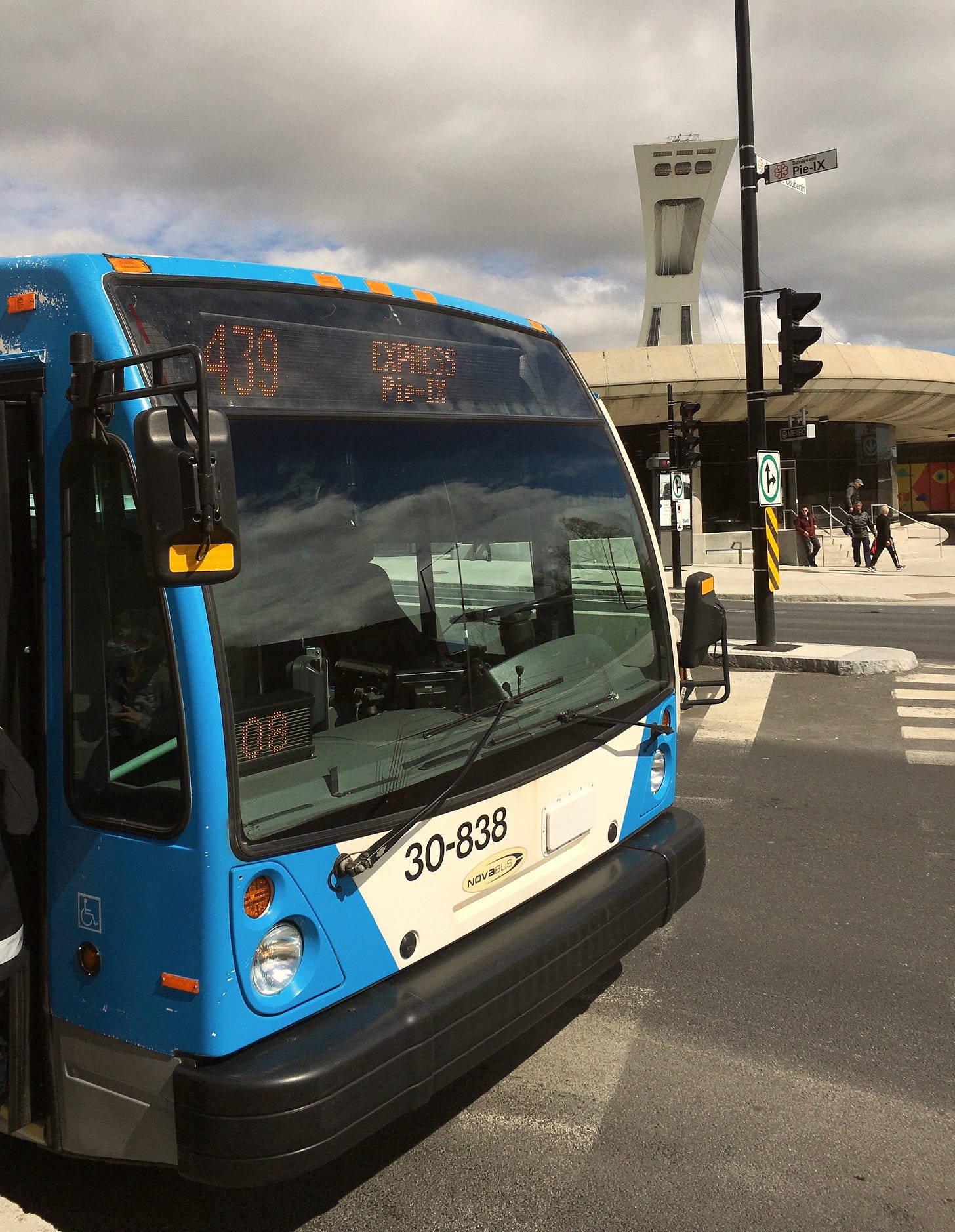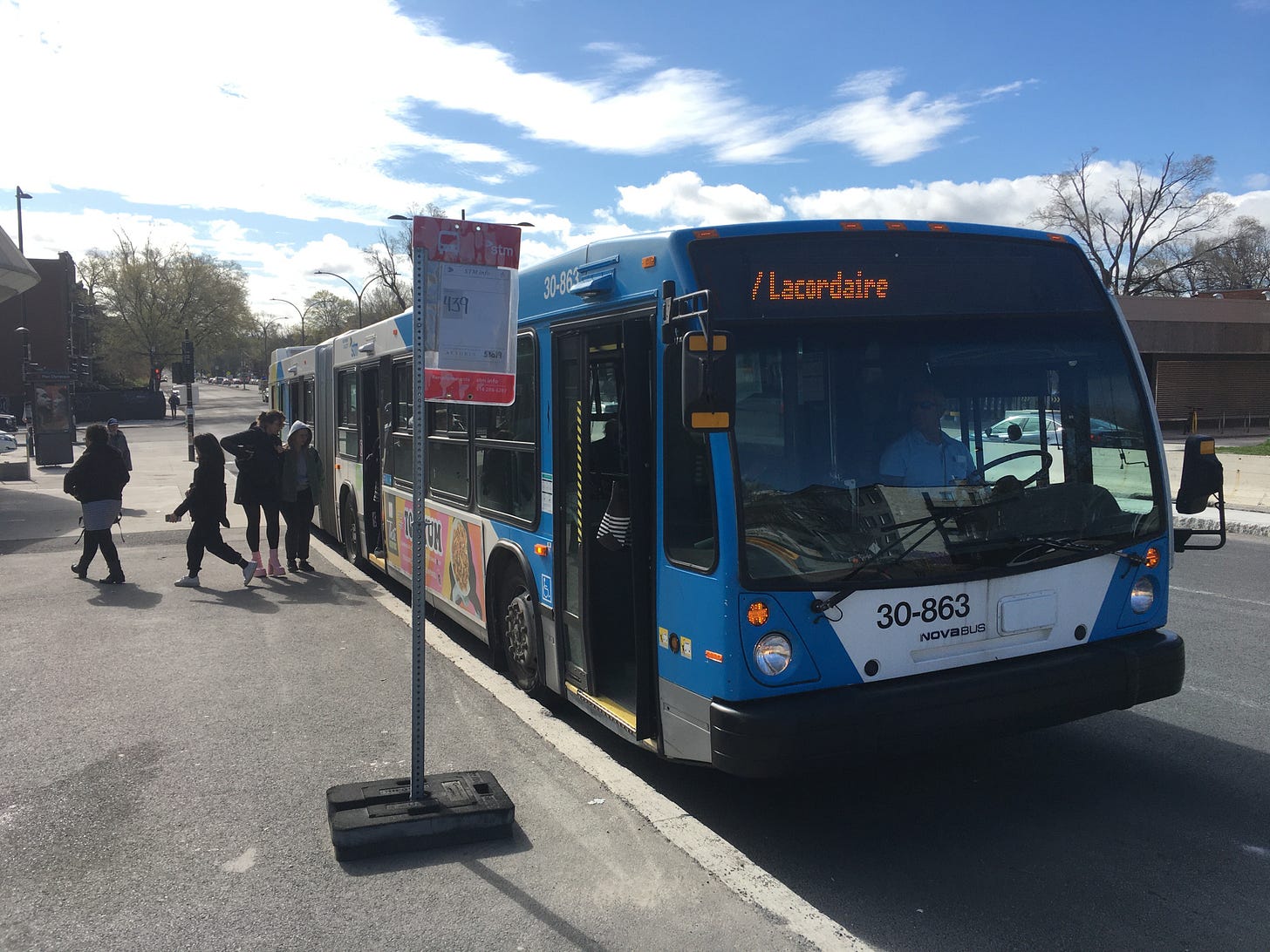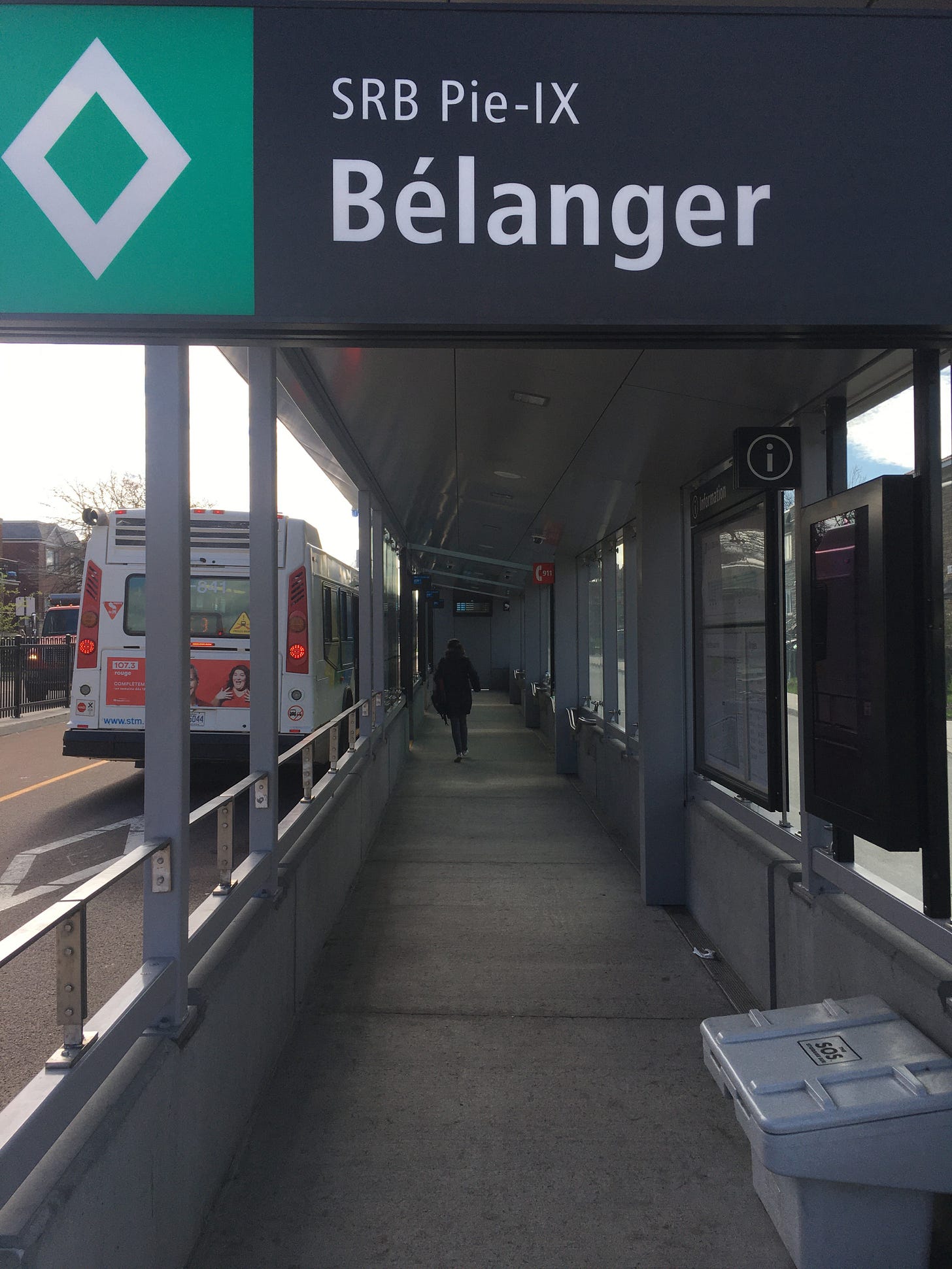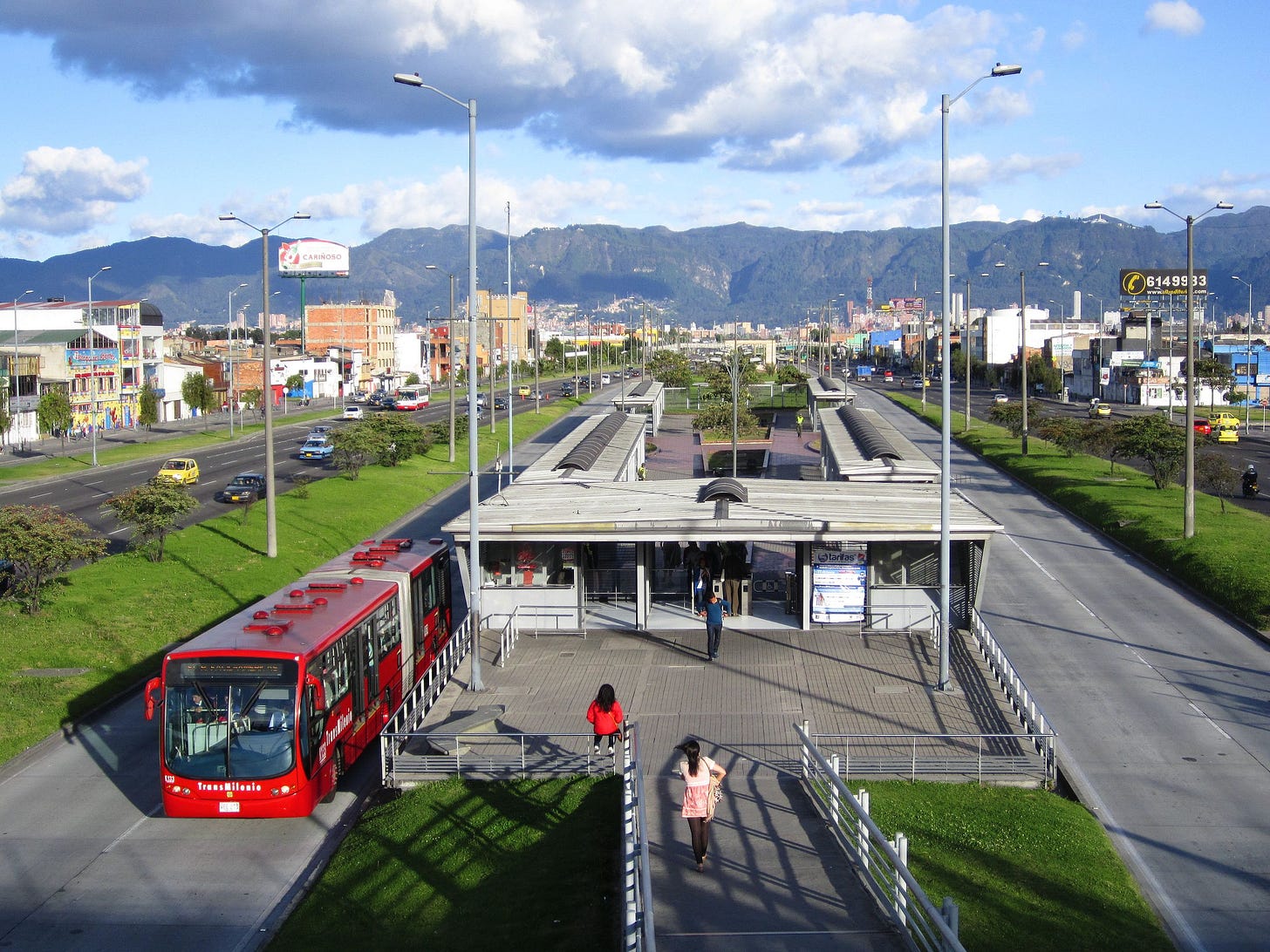Riding the "Subway on the Street"
A Test Drive of North America's Newest Bus Rapid Transit Line
Bus Rapid Transit is a great idea, but one that only rarely gets properly implemented. Especially in the United States and Canada. I’ve ridden BRT systems in Mexico, Colombia, Turkey, and China, and they do exactly what they’re supposed to: they whip riders along at rapid-transit speeds, often past drivers of cars stuck in traffic in adjoining lanes. In Latin America and Asia, well-implemented BRT systems are a perfect example of democracy in action—the masses get Cadillac service (at least in terms of the time they save) while the rich are relegated to donkey class, sucking up fumes as their luxury cars idle in traffic.
As Umberto Eco once wrote, a trifle optimistically, "By riding transit, by consenting not to belong to the elite, you get where you're going before members of the elite do."
When BRT is done right, though, this is exactly what happens. Real BRT, like the superior systems I’ve ridden in Bogotá and Istanbul, has a few important features: all-door boarding, dedicated lanes, prepayment, weather-proof shelters, and signal priority at intersections. (The Institute for Transportation & Development Policy has simplified things by ranking the world’s BRT systems according to gold, silver, and bronze standards, explained here. Though they seem to have fallen a little behind in their rankings lately…) The idea is to minimize dwell time at stops and intersections, and provide the fastest and most comfortable service possible—exactly what people who ride underground mass transit expect. The advantage is that, per kilometer, BRT can be ten times less expensive than digging a new subway tunnel.
I decided to verify whether North America’s latest BRT line actually operates anything like a subway on the street—though, because it runs in the east end of Montréal, I suppose the expression “métro sur un boulevard” would be more apt. It was a nice day, so I rode my bike out to the Pie-IX métro station, by the Olympic Stadium. (Pie-IX, which is named after Pope Pius IX, is pronounced “Pee Neuf” in French; it is a source of great amusement to Montrealers when American tourists roll down their car windows to ask for directions to “Pie Ex.”) The 439 SRB Express (SRB meaning service rapide par bus) began operating in November, 2022, and runs north and south up Boulevard Pie-IX, through some of Montreal’s lower-income neighborhoods, and will eventually cross the river to the east end of the sprawling suburb of Laval.
The trip started inauspiciously. The bus stop, conveniently located outside the entrance to the station (on the east-west Green line), amounted to a hand-lettered sign atop a metal pole. There was nothing special about the bus, either; it was an articulated Novabus, comfortable enough, but with the same blue-and-white livery as any other bus in Montreal’s fleet. (A principle of BRT design is to use a different color to denote the fact that the buses are express, something Los Angeles does well.) I boarded through a rear door (good), tapped my OPUS card at a card reader (it worked, also good), and the bus began driving up Pie-IX towards the Botanical Gardens in mixed traffic (bad).
But then things got interesting. Boulevard Pie-IX is wide enough that two central lanes can be set aside as bus lanes in the middle for much of its length. The bus started running, at speed, along a dedicated lane, which was protected by metal barriers tall and solid enough to prevent cars from entering (excellent!) This was truly an express bus. It only stopped at major intersections—the stations are located after the traffic lights—which made for a shockingly fast ride.
I got off at Bélanger to have a closer look at one of the stations. It actually looked like a station (yes!): glassed in, which will be a great comfort in the winter, with digital information panels showing upcoming arrivals; the driver pulled up so the bus doors were aligned with openings on the platform, and passengers shuffled on through rear and front doors, like they were boarding a subway. (Some systems have subway-like turnstiles at the entrance, meaning you swipe your farecard to access the stations, rather than using a card reader on the bus, which is the case in Montreal.) No benches, though you could lean up against waist-height metal bars.
Just as I was enjoying the feeling of whipping past cars, we took a detour that had us crawling through mixed traffic, like a regular old, poky-ass, second-class bus. This, I learned, was because construction was still underway on a pedestrian passage on Jean-Talon. (For more information on the route and construction schedule, here’s the page on the STM website.) North of Everett, though, we rejoined the dedicated busway. For now, the service remains on the island of Montreal, taking a right-hook to its terminus at Blvd Henri-Bourassa.
For now, too, the frequency—surely the most important thing when it comes to transit service—isn’t up to international BRT standards. Ten to twelve minutes between buses during Friday rush hour? (See the screenshot from the amazing, Montreal-made Transit app below.) Not good. But I suspect this is temporary, and headways will improve when the full build-out to Laval is complete.
Another thing: this is an example of environmental justice. Transit users in Saint-Michel, an immigrant-rich neighborhood that also happens to be one of Canada’s poorer postal codes, are getting the Cadillac service they deserve. The addition of five new stations to the métro’s Blue Line will mean that the BRT will eventually mesh with two subway lines—making it a low-cost addition to a city-wide integrated mass-transit network. (And when the REM opens, we’re going to see serious synergy. This city is going to be a pleasure to get around.)
To sum up: this promises to be a very high-quality BRT line, one of the best I’ve seen in Canada and the United States. In too many other places, BRT exists in name alone. People balk at giving street space to public transit, so you get a glorified express bus. (I saw this recently on Las Vegas’s strip, and in Saskatoon, a proposed BRT along Broadway is running into the usual objections from NIMBY business owners and residents.) We don’t have anything up to the level of service in Latin America or Asia yet—check out the huge buses, overpasses, and excellent stations in the photo of Bogotá’s Transmilenio below. But the Pie-IX BRT is a big step in that direction.
And the beauty of it? They built it in my hometown. Merci—sincèrement!
I hope you’ll consider becoming a paid subscriber to my Straphanger Substack. Almost everybody who’s signed up so far is a “free rider.” No shame in that. But to keep this bus going, I’m going to need at least a few people who are willing to help out by chipping in, even with a low-priced monthly subscription. (I’m talking the price of two taps of your farecard here!)











Good to hear! Thanks for your detailed review. However many decades ago Ottawa built the Transitway, to which it recently added the O-train, although this latter has been plagued with problems, delays and budget overruns. What do you think of the Transitway? I used it a lot as a teenager 30 years ago and it was surprisingly fast and efficient. It made commuting to the far eastern and western suburbs of the city (Orleans and Kanata) fast and affordable.
I passed this along to traffic engineering professor, John Morrall, who tried to at least get a BRT discussion going about Calgary's "West Leg" of our LRT system. He estimated a BRT could have served any possible business that line could generate - estimated at most at 30,000/day for the first few decades - for not much over $100M.
But, no, for pride's sake, it had to be LRT, they wouldn't even discuss a lesser solution than a full train. He couldn't even get a BRT discussed. The train involved massive roadworks, creating a new train path between the halves of a newly-divided major road, and elevated stations, the full bit - came in over $1.4B and they can't possibly pay the interest with tolls, even if there were no operating costs.
Painful, therefore, to see how well a BRT would have met the same need.